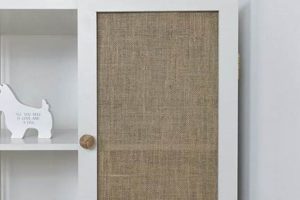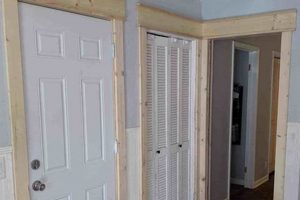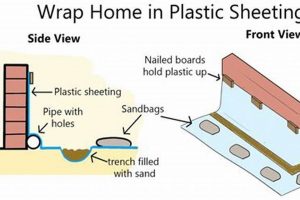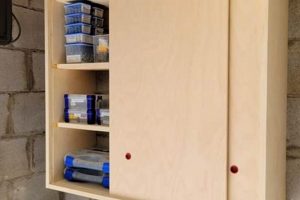A specific style of cabinetry construction involves creating a five-piece door with a recessed center panel. This design, characterized by its clean lines and simple, unadorned frame, is a popular choice for kitchen and bathroom renovations. The resulting aesthetic is often described as timeless and versatile, fitting well with a range of interior design styles from traditional to modern.
This construction method offers several advantages. Its straightforward design lends itself well to cost-effective manufacturing or construction. The resulting cabinet doors are durable and easy to maintain. Historically, this style gained prominence for its functional simplicity, reflecting a move away from elaborate ornamentation and towards practicality in household furnishings. Its enduring appeal stems from its adaptability and ability to complement various decor themes.
The subsequent sections will detail the materials, tools, and step-by-step instructions necessary for constructing this type of cabinet door. Further considerations will include finishing techniques and hardware selection, providing a complete guide for achieving professional-quality results.
Essential Construction Guidance
The following recommendations aim to enhance the quality and longevity of handcrafted cabinetry using the specified method, minimizing potential errors and maximizing structural integrity.
Tip 1: Prioritize precise measurements. Accurate dimensions are crucial for ensuring a square and uniform frame. Double-check all measurements before cutting any materials.
Tip 2: Select appropriate wood species. Hardwoods such as maple, oak, or cherry offer greater durability for frames, while MDF or paint-grade poplar can be cost-effective choices for center panels.
Tip 3: Employ consistent joinery techniques. Mortise and tenon, rabbet, or cope-and-stick joints provide robust connections between frame components. Select the most appropriate joinery method based on skill level and available tools.
Tip 4: Utilize high-quality wood glue. Ensure proper clamping pressure is applied during glue-up to create strong and lasting bonds between frame components.
Tip 5: Sand surfaces thoroughly. Proper surface preparation is essential for achieving a smooth and professional finish. Sand all components before assembly and again after glue-up.
Tip 6: Apply a primer coat before painting. Priming ensures uniform paint adhesion and prevents the wood from absorbing too much paint, improving the final appearance and durability.
Tip 7: Choose durable topcoat finishes. Selecting a high-quality paint or varnish will protect the wood from moisture, scratches, and stains, extending the lifespan of the cabinetry.
Adherence to these guidelines will improve the overall quality and longevity of this style of cabinetry construction. Attention to detail throughout the process is paramount.
The article will now proceed to address potential troubleshooting scenarios and advanced techniques for customization.
1. Frame Material Selection
Frame material selection constitutes a critical decision point in the construction of cabinet doors. The choice of material directly impacts the structural integrity, longevity, and aesthetic qualities of the finished product, particularly within the context of creating this specific door style. The material dictates not only the door’s resistance to wear and tear but also its susceptibility to moisture, warping, and impact damage.
- Hardwood Durability
Hardwoods, such as maple, oak, and cherry, offer superior strength and resistance to dents and scratches. Their density allows for cleaner joinery and a more rigid frame, making them suitable for high-use environments like kitchens. For example, oak’s distinctive grain pattern can add visual interest to the design, while maple provides a smoother surface for painting. However, hardwoods tend to be more expensive and require specialized tools for precise cutting and shaping.
- Softwood Affordability
Softwoods, like pine and poplar, present a more cost-effective alternative. They are easier to work with, requiring less force and specialized tooling. However, they are more prone to dents and scratches, making them less ideal for high-traffic areas. Poplar, in particular, is often used for paint-grade projects due to its smooth, even grain and ability to accept paint well, mitigating some of the durability concerns of other softwoods. The choice of softwood must consider the door’s intended use and expected wear.
- Engineered Wood Stability
Engineered wood products, such as MDF (Medium Density Fiberboard), offer stability and uniformity. MDF is less prone to warping and splitting compared to solid wood, making it a suitable choice for center panels or painted frames. Its consistent density allows for smooth paint finishes. However, MDF is more susceptible to water damage and lacks the natural grain character of solid wood. The decision to use engineered wood must account for environmental factors and desired aesthetic outcomes.
- Moisture Resistance Considerations
Regardless of the material chosen, moisture resistance is a paramount consideration for cabinet doors, especially in kitchens and bathrooms. Solid wood can be treated with sealants and finishes to improve water resistance, while engineered wood products should be carefully sealed to prevent swelling and delamination. The selection process must weigh the material’s inherent moisture resistance properties against the environmental conditions it will be exposed to.
The selection of frame material exerts a profound influence on the overall performance and aesthetic of the cabinetry. Balancing considerations of durability, cost, workability, and moisture resistance is critical for achieving a successful and lasting outcome. Ignoring these factors can lead to premature failure or dissatisfaction with the finished product.
2. Center Panel Dimensions
The dimensions of the center panel in a specifically styled cabinet door directly influence the overall aesthetic appeal and structural stability of the completed unit. The proper sizing and execution of this component are critical to achieving the intended design and function.
- Impact on Visual Proportion
The size of the center panel relative to the surrounding frame dictates the visual balance of the door. A panel that is too small can make the frame appear bulky and overwhelming, while a panel that is too large can diminish the frame’s presence and the character of the door. The appropriate ratio between the frame and panel dimensions is crucial for achieving a visually harmonious result. Careful consideration must be given to these proportions during the design phase.
- Material Expansion and Contraction
Center panel dimensions must account for the expansion and contraction of the panel material due to changes in humidity and temperature. Solid wood panels will expand and contract significantly more than engineered wood products like MDF. Leaving adequate space within the frame’s rabbet allows the panel to move without causing stress on the frame joints. Failure to accommodate this movement can lead to panel cracking, frame distortion, or joint failure.
- Influence on Door Stability
The center panel contributes to the overall stability of the cabinet door. While the frame primarily provides the structural support, the panel acts as a bracing element. Precisely sized and fitted panels help to maintain the door’s squareness and prevent racking. Inadequate panel dimensions or loose fitting can compromise the door’s rigidity and shorten its lifespan. The panel’s fit within the frame directly affects the longevity of the assembled structure.
- Rout depth and Panel Groove Alignment
Ensuring appropriate depth for panel grooves during assembly impacts cabinet door joinery and alignment during the installation of the panel. Proper fitting guarantees that the panel is held firmly inside, which leads to stability and ensures there is room for expansion and contraction without jeopardizing the doors overall alignment. Therefore during the construction process special care is taken to ensure there are no warps that could occur due to these issues and impact overall stability.
The interplay between the center panel dimensions and these factors dictates the quality of the cabinet door. Careful planning, precise measurements, and appropriate construction techniques are essential for realizing a structurally sound and aesthetically pleasing product.
3. Joint Construction Technique
The selection and execution of joinery techniques are fundamental to the structural integrity and longevity of specifically styled cabinet doors. These techniques directly impact the strength, stability, and aesthetic appeal of the finished product. The appropriate joinery method ensures that the frame members are securely connected, capable of withstanding daily use and environmental changes.
- Mortise and Tenon Joint
The mortise and tenon joint is a traditional method involving a projecting tenon (tongue) from one piece of wood that fits precisely into a mortise (hole) in another. This joint provides exceptional strength and resistance to racking forces, making it ideal for cabinet door frames. The precise fit and ample glue surface area create a durable and long-lasting connection. Example: This joint is commonly used in high-quality furniture and architectural millwork where structural integrity is paramount. Its application in cabinet doors ensures resistance to warping and separation over time.
- Cope and Stick Joint
The cope and stick joint is a specialized method tailored for door and frame construction. It involves shaping the edges of the frame components with matching profiles that interlock when assembled. This technique facilitates the creation of decorative edges and provides a large glue surface area, resulting in a strong and visually appealing joint. Example: This joint is commonly employed in mass-produced cabinet doors due to its efficiency and ability to create intricate designs. In a shop setting, cope and stick joints can be quickly and accurately produced with specialized router bits.
- Mitered Joint
A mitered joint involves cutting the ends of two pieces of wood at equal angles (typically 45 degrees) to form a corner. While visually appealing, mitered joints are inherently weaker than other joinery methods due to the limited glue surface area. Reinforcement with splines, biscuits, or dowels is often necessary to increase their strength. Example: Mitered joints are frequently used for picture frames and decorative trim where aesthetics are prioritized over structural strength. The mitered joint may be used for this door style with proper reinforcement applied.
- Rabbet Joint
The rabbet joint involves creating a recess or channel along the edge of one piece of wood into which another piece fits. This joint is relatively simple to execute and provides a decent glue surface area. It is commonly used to join the frame members to the center panel of a cabinet door. Example: The rabbet joint is often found in drawer construction and simpler woodworking projects. In cabinet door construction, it provides a straightforward means of securing the center panel within the frame, providing both structural support and dimensional stability.
The choice of joint construction technique directly influences the durability, stability, and aesthetic of the cabinet door. Factors such as skill level, available tools, and desired level of structural integrity must be considered when selecting the appropriate method. The correct execution of the chosen joint ensures a cabinet door that is both functional and visually appealing, contributing to the overall quality and longevity of the cabinetry. These techniques influence quality from long term use.
4. Accurate Miter Cuts
Accurate miter cuts are paramount in the construction of high-quality specifically styled cabinet doors. The joints created by precisely angled cuts form the corners of the door frame, impacting both the structural integrity and the aesthetic appeal of the finished product. Inaccurate miter cuts lead to gaps, misaligned corners, and a compromised frame, diminishing the overall quality of the cabinet.
The repercussions of imprecise cuts extend beyond mere aesthetics. A misaligned corner weakens the entire frame, making it susceptible to warping, racking, and eventual failure under stress. This is especially critical in kitchen environments where cabinets endure frequent use and exposure to moisture and temperature fluctuations. Therefore, employing precision measuring tools, a sharp saw blade, and a stable cutting platform becomes indispensable. A real-world example of the significance of precision can be observed in professionally manufactured cabinet doors, where computer-controlled machinery ensures consistent and accurate cuts, resulting in robust and visually flawless products.
In summary, achieving accurate miter cuts presents a significant challenge for those engaging in cabinet door construction. Overcoming this challenge necessitates meticulous measurement, precise cutting techniques, and a commitment to quality craftsmanship. Addressing these challenges effectively translates to enhanced durability, aesthetic appeal, and overall value of the handcrafted cabinetry, effectively reflecting the commitment to the traditional form.
5. Glue and Clamp Strength
The structural integrity of a specifically styled cabinet door hinges significantly on the effectiveness of glue and clamping procedures during assembly. The strength of the adhesive bond, coupled with adequate clamping pressure, directly determines the durability and longevity of the door. Improper application or inadequate clamping can lead to weakened joints, panel separation, and premature failure.
- Joint Integrity
The primary function of wood glue is to create a bond stronger than the wood itself. The selected adhesive must be appropriate for the wood species used and capable of withstanding the stresses placed on cabinet doors, such as humidity changes and regular use. For instance, polyvinyl acetate (PVA) glues are commonly used for interior applications, while polyurethane glues offer greater water resistance for exterior use. Insufficient glue application results in voids and weak points within the joint, increasing the likelihood of separation over time. A properly glued joint, when subjected to stress, should cause the wood to fail before the glue line.
- Clamping Pressure Distribution
Clamping serves to maintain consistent pressure on the glued surfaces, ensuring optimal contact and bond formation during the curing process. The appropriate clamping pressure varies depending on the wood species and adhesive used. Excessive pressure can starve the joint of glue, while insufficient pressure can result in a weak bond. Even distribution of clamping force is equally crucial to prevent warping or misalignment. A real-world example is the use of pipe clamps with adjustable pads, which allow for even pressure distribution across the entire joint surface. The number and placement of clamps must be carefully considered to achieve uniform pressure.
- Curing Time Adherence
Wood glues require a specific curing time to achieve full strength. Premature removal of clamps can disrupt the bonding process and compromise the joint’s integrity. Adhering to the manufacturer’s recommended curing time is essential. Factors such as temperature and humidity can also affect curing time, potentially requiring adjustments to the recommended duration. In a production setting, climate-controlled environments are often used to ensure consistent curing conditions. Impatience in removing clamps can negate the benefits of proper glue application and clamping pressure.
- Glue Cleanup and Joint Inspection
Excess glue squeeze-out can interfere with finishing and create unsightly blemishes. Removing excess glue before it fully cures is necessary for achieving a clean and professional finish. Equally important is a thorough inspection of the joints after clamping. Any gaps or signs of inadequate glue coverage indicate a compromised joint that requires immediate attention, potentially necessitating disassembly and re-gluing. The glue squeezeout can act as a physical sign of a proper glue application and proper clamping force was implemented during the project.
These facets underscore the critical relationship between glue and clamp strength and the successful construction of a cabinet door. Precise application, adequate pressure, and proper curing are all interdependent factors that contribute to the creation of a durable and aesthetically pleasing cabinet component. Neglecting any of these aspects jeopardizes the long-term performance and visual appeal of the cabinet door, undermining the effort invested in its construction.
6. Sanding and Preparation
Sanding and preparation are foundational stages in crafting aesthetically pleasing and structurally sound cabinet doors. Proper execution ensures a smooth surface for finishing and promotes optimal adhesion of coatings. Omission or inadequate performance of these steps compromises the final appearance and durability of the finished product. These are essential because without these steps properly handled and done you will get a non durable aesthetic.
- Surface Smoothing and Defect Removal
Sanding eliminates imperfections such as scratches, dents, and milling marks from the wood surface. Progressing through a series of increasingly finer grits, typically starting with 80-grit and culminating in 220-grit, refines the surface texture. This process is critical for paint-grade finishes where even minor blemishes are amplified. For example, failure to remove planer marks on frame components results in visible ridges through the paint, detracting from the door’s appearance. Therefore removing and smoothing the surface increases the durability and overall aesthetic.
- Edge Rounding and Profile Definition
Sanding can be used to soften sharp edges and define profiles, enhancing both the tactile feel and visual appeal of the cabinet door. A slightly rounded edge is more comfortable to the touch and less prone to chipping or damage. Similarly, careful sanding of decorative profiles ensures crisp, clean lines. The correct application enhances the safety and the physical appeasing of the piece.
- Adhesion Promotion for Coatings
Sanding creates a mechanical key for coatings to adhere to. The microscopic scratches left by the sandpaper increase the surface area and provide a textured surface for primers, paints, and stains to grip. Without proper sanding, coatings are more likely to peel, chip, or flake. A practical illustration of this is the comparison between a properly sanded surface and a glossy, unsanded surface coatings will adhere significantly better to the former. This adhesion will increase durability of paint and coatings.
- Contamination Removal
Preparation includes removal of any contaminants that will hinder the adherence of your coatings. This could be oils, dust, or anything that stops the primer from adhering to the surface. If you do not properly remove these contaminants it is likely that the coating will eventually start peeling at the source of contamination. Ensuring a clean surface is paramount to achieving that level of protection for coatings and therefore the lifespan of the design.
These preparation practices are a prerequisite for creating a cabinet door that is not only aesthetically pleasing but also capable of withstanding the rigors of daily use. Consistent sanding, appropriate edge detailing, and careful attention to surface cleanliness are integral to achieving professional-grade results, ensuring the longevity and overall satisfaction with the finished product.
7. Finishing Application
The finishing application phase profoundly influences the visual characteristics and protective qualities of a constructed cabinet door. The chosen finish directly impacts the aesthetic appeal and durability of the cabinetry. An appropriate application shields the wood from moisture, scratches, and UV radiation, extending the lifespan of the structure. Conversely, an improper finish may result in premature deterioration, discoloration, or an unappealing texture. The nature of the wood, the desired aesthetic, and the anticipated usage conditions should dictate the selected finishing method. The importance of this selection has a direct impact on the overall finished look of the door.
Practical applications are diverse. For example, a kitchen cabinet door constructed from oak, intended for frequent use, may benefit from a durable polyurethane finish that resists water and abrasions. Conversely, a bathroom cabinet door made from poplar, intended for a less demanding environment, may be adequately protected with a coat of paint and varnish. Real-world scenarios illustrate the importance of considering the operating environment. In coastal regions with high humidity, marine-grade finishes may be necessary to prevent moisture damage. A poorly chosen finish can lead to peeling paint, water stains, and wood rot, necessitating costly repairs or replacements. Application techniques also have a large roll to play for the end results and durability.
In summary, the finishing application is an integral component of the door creation process. Careful consideration of material selection, environmental factors, and intended use is paramount. Proper surface preparation, combined with the appropriate application of a high-quality finish, guarantees a durable and aesthetically pleasing outcome. Mastering this aspect addresses potential challenges and maximizes the longevity and value of the handcrafted cabinetry, tying directly into the broader theme of quality and durability. It is also the final visual aspect the user will receive to the craftsmanship and care put into a construction.
Frequently Asked Questions about Constructing Specifically Styled Cabinet Doors
The following section addresses common inquiries regarding the materials, techniques, and potential challenges encountered during the construction of these doors.
Question 1: What is the optimal wood species for constructing the frame?
Hardwoods, such as maple, oak, or cherry, offer superior durability and stability for the frame. Softwoods, like poplar or pine, may be suitable for paint-grade applications but are generally less resistant to wear and tear.
Question 2: What is the recommended thickness for the center panel?
A center panel thickness of 1/4 inch to 3/8 inch is generally sufficient for stability and aesthetic appeal. Thicker panels may be used for larger doors, but can add unnecessary weight.
Question 3: Which joinery method provides the most robust frame construction?
Mortise and tenon joints offer exceptional strength and resistance to racking forces. Cope and stick joints are also commonly used and can provide adequate strength when properly executed.
Question 4: How does humidity affect the constructed door?
Wood expands and contracts with changes in humidity. Adequate allowance must be made for panel movement within the frame to prevent warping or cracking. Sealing all surfaces with a moisture-resistant finish is also recommended.
Question 5: What is the best method for achieving a smooth paint finish?
Thorough sanding, application of a high-quality primer, and the use of a fine-finish spray gun are essential for achieving a smooth paint finish. Multiple thin coats of paint are preferable to a single thick coat, which can lead to runs and drips.
Question 6: How can warping be prevented after assembly?
Using kiln-dried lumber, ensuring proper joint construction, and applying a balanced finish to all surfaces can help prevent warping. Storing the doors flat during construction and acclimation is also important.
These answers offer guidance on navigating common challenges in this project. Careful planning and execution are paramount.
The next section will provide information on finishing techniques for specifically styled cabinet doors.
Conclusion
This exploration has provided a detailed overview of considerations involved in creating specifically styled cabinet doors. It emphasized the importance of material selection, precise joinery, accurate cutting, and proper finishing techniques. The structural integrity, aesthetic appeal, and long-term performance of the cabinet doors depend significantly on diligent attention to each of these phases.
The successful execution of this construction necessitates a combination of knowledge, skill, and meticulous attention to detail. While presenting challenges, the creation of these doors offers an opportunity to customize cabinetry to specific needs and preferences. Continued dedication to refining skills and understanding the nuances of woodworking will undoubtedly contribute to achieving superior results in future projects.







